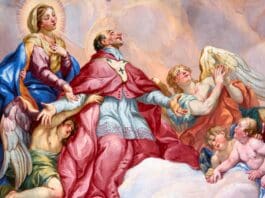
Saint Charles Borromeo, a notable figure of the Catholic Reformation, was born into nobility as the offspring of Count Gilbert Borromeo and Margaret Medici, who was the sister of Pope Pius IV. His birthplace was the majestic Borromeo castle in Arona, situated by the picturesque Lake Maggiore in Italy, on October 2. At the tender age of twelve, he embarked on his clerical journey with the tonsure and began his education at the Benedictine abbey of SS. Gratian and Felinus in Arona.
The year 1559 marked a pivotal turn in his life when his uncle ascended to the papacy as Pope Pius IV. One year later, Charles’s ecclesiastical career escalated; he was appointed Secretary of State, elevated to the cardinalate, and given administrative charge over the Archdiocese of Milan. His diplomatic acumen shone through as he undertook several legations for the pope and was pivotal in the revival of the Council of Trent in 1562, which had previously been interrupted.
As a cardinal, Charles was instrumental in the Council’s final phase, shaping its groundbreaking decreacies with foresight and dedication. He declined the leadership of the Borromeo family upon the death of Count Frederick Borromeo, choosing instead to fully embrace his ecclesiastical duties by receiving ordination as a priest in 1563 and consecration as the bishop of Milan in the same year. Before assuming his episcopal responsibilities, he diligently prepared the catechism, missal, and breviary mandated by the Council of Trent.
Upon his arrival in Milan in 1556, after the diocese had languished without a bishop for eight decades, he executed sweeping reforms with such success that the diocese became a paragon for others. His efforts ranged from elevating the moral conduct of both clergy and laity to enhancing diocesan operations. He was pivotal in establishing seminaries for clergy education and founded a Confraternity of Christian Doctrine to catechize children, also supporting the Jesuits within his jurisdiction. His benevolence extended to the needy, and he notably supported the English college at Douai.
His episcopacy was marked by the convocation of multiple diocesan and provincial councils. In 1578, he founded the society of secular priests known as the Oblates of St. Ambrose, later named the Oblates of St. Charles. His endeavors also included fervent preaching, countering Protestant advances, and guiding lapsed Catholics back to the fold of the Church. Despite facing opposition, his reformative zeal never waned.
Saint Charles Borromeo’s earthly mission concluded in Milan on the night spanning November 3-4. His legacy of piety and ecclesiastical reform was honored with canonization in 1610. As a patron of learning and the arts, his life was a testament to the power of humility and virtue in addressing the church’s challenges during tumultuous times. His commemoration is held on November 4th, the date of his feast day, honoring his enduring influence as a patron saint of learning and the arts.
Photo credit: Public Domain via Wikimedia Commons
The post Saint Charles Borromeo appeared first on uCatholic.
Daily Reading
Monday after Epiphany
Reading 1 1 John 3:22–4:6 Beloved: We receive from him whatever we ask, because we keep his commandments and do what pleases him. And his commandment is this: we should…
Daily Meditation
The BribeEl soborno
Click here for daily readings It is a little strange being a parent of two little boys. There are so many moments that I look back and remember myself as…




